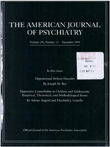A family study of DSM-III-R schizoaffective disorder, depressive type, compared with schizophrenia and psychotic and nonpsychotic major depression
Abstract
OBJECTIVE: To assess the validity of DSM-III-R schizoaffective disorder, the authors explored the morbid risks for schizophrenia and major affective disorders in the first-degree relatives of patients with schizoaffective disorder and relevant other diagnoses. METHOD: In addition to patients with DSM-III-R schizoaffective disorder, depressive type (N = 21), the probands included patients with mood- incongruent psychotic depression (N = 22), mood-congruent psychotic depression (N = 19), nonpsychotic depression (N = 27), or schizophrenia (N = 28) and normal subjects (N = 18). The patients were consecutively recruited from the outpatient facilities of a university psychiatry department; the normal subjects were students and nurses. All probands were directly interviewed, with the Schedule for Affective Disorders and Schizophrenia--Lifetime Version (SADS-L), by a psychiatrist blind to information about relatives. Consenting relatives were directly interviewed, with the SADS-L, by two psychiatrists blind to the probands' diagnoses. The direct interview was supplemented--or replaced, when an interview was not possible (24%)--by family history data from all available sources. Morbid risks in relatives were calculated according to the Weinberg method. RESULTS: The relatives of the schizoaffective patients had almost the same risk for schizophrenia as the relatives of the schizophrenic patients. In the relatives of the patients mood-incongruent psychotic depression, the morbid risk for major affective disorders was about one-half that of the relatives of the patients with mood-congruent psychotic depression and one-third that of the relatives of the patients with nonpsychotic depression, but these differences did not reach statistical significance. CONCLUSIONS: These results suggest that DSM-III-R schizoaffective disorder is close to schizophrenia and largely corresponds to mainly schizophrenic schizoaffective disorder in the Research Diagnostic Criteria, whereas DSM-III-R mood-incongruent psychotic depression is probably quite heterogeneous and should be studied further.
Access content
To read the fulltext, please use one of the options below to sign in or purchase access.- Personal login
- Institutional Login
- Sign in via OpenAthens
- Register for access
-
Please login/register if you wish to pair your device and check access availability.
Not a subscriber?
PsychiatryOnline subscription options offer access to the DSM-5 library, books, journals, CME, and patient resources. This all-in-one virtual library provides psychiatrists and mental health professionals with key resources for diagnosis, treatment, research, and professional development.
Need more help? PsychiatryOnline Customer Service may be reached by emailing [email protected] or by calling 800-368-5777 (in the U.S.) or 703-907-7322 (outside the U.S.).



